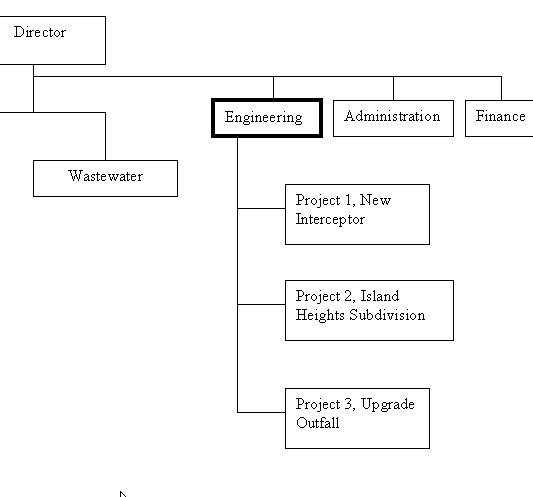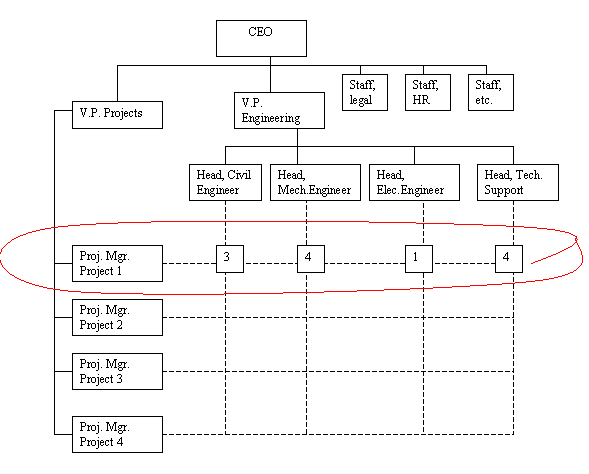
Module 5
First a reality check. At first reading, this chapter seems only important to the project manager if she has some choice about the organization of the parent company and the project administration - a separate office or whatever. Project managers are in that position almost never. So why bother. The answer is that the organization of the parent company and the realities of project administration within that company are the environment where the project will be performed. Knowing more about your environment gives you an advantage when planning your activities and also gives you a direction (and some favorable arguments) when it is possible to change some aspect of that environment. So, don't take the chapter and my descriptions below as a botany course, where you memorize the names of the flowers. Think of it as an early warning system to help you anticipate future problems that are likely to spring from particular organizational environments.
Many businesses have several organization structures. For example Exxon had four major divisions as of the mid-2000s:
Within each there may be subdivisions, either by functions, note the four downstream companies, or by geographic area. Finally, say we are talking about Exxon's coal mining organization in Brazil, it might be organized by each of its 5 Brazilian mines or into: production, transportation and marking for Brazil. Either way these are functional organizations.
In Module 3 we described a functional organization, the San Francisco Department of Public Works, and suggested it has two major functions, design/construction and operations. Now consider a different DPW which might have engineering in a staff role. This DPW could be organized such that, say, water and wastewater, among others, are strictly routine functions and all planning, engineering, and construction are handled by the Engineering Department. In that case, the Engineering Department is likely to be a projectized organization. Here's how it might be organized.

That is, all the engineering employees "charge their time" to a project, except perhaps for the director and a few office people. The completed projects are "turned over" to the functional departments. Here you might think of the Wastewater Department as the "client" of the wastewater projects.
The most common type of organization in engineering and construction entities is the matrix organization.

The project manager of Project 1 went to the Head Civil Engineer and had 3 civils assigned to his project, then to the Head Mechanical to get 4 MEs, the Head Electrical to get 1 EE, and finally the Head of the Technical Support to get 4 technicians, all assigned to Project 1. (I call these "discipline heads"or chiefs.) When the electrical portion of Project 1 is complete, the Project Manager of Project 1 will send the EEs back to Head Electrical for reassignment. If the project managers need advice or temporary help, they can likewise go to the discipline head of the right technical department and request that assistance. The other projects are similar (I didn't bother to fill in examples of the staffing levels). A variation on this theme for industrial firms might be that instead of discipline heads, those are existing functional departments that are expected to supply people and or expertise to the project as needed. Meredith distinguishes a strong matrix as above, where the worker bees are assigned to the project manager, who becomes their day-to-day supervisor, from a weak matrix, where the project manager might be the only full-time worker on the project, the other project members are assigned only temporarily and their day-to-day supervision remains with their functional or discipline head.
In an ideal projectized matrix world, the project manager makes a laundry list of the technical qualifications needed, supplements that with notes on the personalities required, "This project needs an EE with 15 years experience in digital vebelvitzers, who doesn't mind working in a cubicle next to a guy with a rattail haircut who hums country and western tunes when he's nervous." The PM then asks the discipline or functional managers and receive workers meeting those specifications the next day. What really happens is that discipline head sends the PM the people who are sitting around his shop, the functional managers will send you the "culls and kids," and the PM will have to build a perfect project with imperfect people. That why in Section 4.7 Meredith points out some of the human factors and gives some points on motivating people. All the systems he mentions and the gurus he quotes fail in the long run because people are people and one size does not fit all. Having a good plan for motivating the team and being aware of points of conflict are required, but only as "openers," after that, the project manager has to do the best he can with what he's got. Or, one of my favorite sayings, "management is the art of running a day care center for adults."